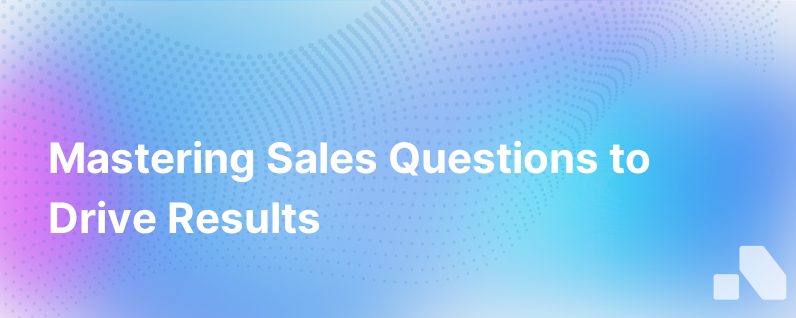Sales Questions
Published on August 26, 2023 by David Zhang
The art of asking the right sales questions cannot be overstated in the realm of B2B transactions. The ability to discover the nuanced needs, challenges, and goals of your potential clients is pivotal in tailoring your pitch and engaging in a meaningful conversation that leads to a successful sale. This exploration unravels with a delicate balance of open-ended inquiries, reflective listening, and insightful probing—all essential components in crafting a dialogue that resonates.
The Purpose of Sales Questions
Sales questions serve a multitude of purposes that extend beyond mere information gathering. They are the conduit through which sales professionals can:
- Establish rapport and empathy by showing genuine interest in the client's situation.
- Uncover the explicit needs and subconscious desires that dictate purchasing behavior.
- Qualify leads effectively to ensure a fit between the customer's needs and your solution.
- Diagnose the customer's pain points, which sets the stage for a solution-centric discussion.
- Invite collaboration and co-create a vision for how your product or service can address their challenges.
- Objection handle proactively by understanding any hesitations or barriers to purchase.
Executing this strategy proficiently demands a vast repertoire of questions, each designed to illuminate a different facet of the customer's circumstances and aspirations.
Crafting the Right Questions: A Strategic Approach
Open the Conversation: Building Rapport
The initial step in engaging a client is to lower their guard and foster a comfortable dialogue. Questions at this stage should be light yet insightful, prompt storytelling, and show that you see beyond mere transactions.
- Can you share a bit about your journey with [company] so far?
- I noticed [recent company achievement or news]; how has that impacted your team's dynamics?
Identifying Needs: The Discovery Phase
Once you've established a congenial environment, it's time to delve deeper with questions that unpack the customer's needs. This is the most critical phase—the discovery phase—where you lay the groundwork for your value proposition and solution alignment.
- What are your top priorities for this quarter/year?
- Can you walk me through a typical workflow and where you encounter bottlenecks or inefficiencies?
- What does a successful outcome look like for your team in relation to [specific problem or goal]?
- If you could change one aspect of your current process, what would it be and why?
Clarifying Pain Points: The Diagnostic Stage
As clients narrate their experiences, pain points start to emerge. This is your cue to ask pointed questions that not only clarify these issues but also amplify the urgency for a remedy.
- How does this challenge affect your daily productivity?
- Can you quantify the impact this issue has had on your bottom line?
- What are the consequences if these problems aren't resolved?
- Has there been a solution you've tried in the past that didn't work out? What was missing?
Establishing Value: The Solution Positioning
With a firm grasp of their pain points, you can pivot to positioning your solution without sounding presumptive. This is where you turn features into tangible benefits.
- If we could provide a solution that addresses [specific pain point], how would that reshape your team's workflow?
- In what ways would streamlining this process have an impact on your team's morale?
Gauging Commitment: The Qualification Process
As the conversation unfolds, you'll need to assess the prospect's commitment to solving the problem. These questions help filter the serious opportunities from those less inclined to take action.
- What's your timeline for implementing a solution?
- Have you already allocated budget for this issue, or is it something we need to plan for collectively?
- Who else in your organization needs to be involved in making this decision?
Overcoming Objections: The Reassurance
Even the most interested prospects might have reservations. There's no better time to address these than at the moment they arise.
- What concerns do you have about implementing a new solution?
- Are there any roadblocks we should be aware of that could potentially delay the adoption of a new solution?
Closing: The Commitment
As the dialogue reaches a crescendo, closing questions secure the commitment. They should be direct yet non-threatening— carried by the trust you've built throughout the conversation.
- Does our solution align with your vision for addressing [specific pain point]?
- What would be the next step you're most comfortable taking from here?
Implementing a Dynamic Sales Questioning Strategy
Tailoring your questioning strategy to the unique circumstances of each prospect is both an art and a science. It requires active listening, adaptability, and an understanding that not every conversation will follow a textbook pattern. The sales professional’s role is to guide the conversation, not dominate it.
Equally important is the systematic organization and analysis of the information uncovered. Leveraging tools and platforms, such as Aomni, can help automate these tasks, ensuring that no data is lost and every interaction is maximized.
Conclusion
Mastering the sales questioning technique is akin to navigating a complex maze—one that leads to a deeper understanding of your client's world and places your solution as the definitive answer to their needs. When utilized effectively, strategic questioning can elevate your sales process from a function of commerce to a partnership predicated on value and trust.
Consistently refining your question bank, understanding the ebb and flow of a sales dialogue, and capitalizing on AI tools like Aomni to inform your approach are all instrumental in scaling your B2B sales operations and ensuring sustained success.